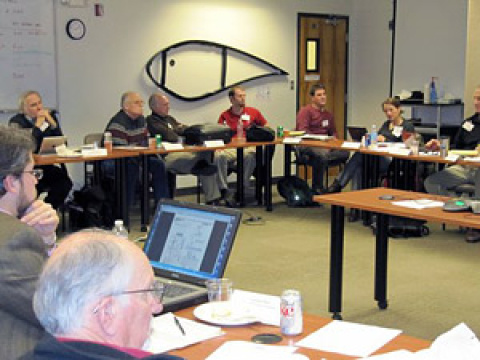Wind Powering America Hosts Fifth Annual Wind for Schools Summit
Wind Energy Technologies Office
February 24, 2012This is an excerpt from the First Quarter 2012 edition of the Wind Program R&D Newsletter.
On January 12 and 13, 2012, Wind Powering America hosted its fifth annual Wind for Schools Summit at the National Renewable Energy Laboratory, National Wind Technology Center near Boulder, Colorado. During the 2-day event, attendees shared their experiences from the past year, future concerns, and overall developments in their individual programs.
Forty attendees representing the 11 official Wind for Schools states and related stakeholders met to discuss ways to further the Wind for Schools projects in their states.
Wind for Schools project leader Charles Newcomb described the event as a mutually beneficial experience for the Wind Powering America team and the Wind for Schools participants. "This summit gives them an opportunity to engage in conversation that gives everyone a much better perspective," Newcomb said. "It was really helpful to get their updates, hear about their challenges, and see how people are overcoming some of the issues."
Newcomb added that this summit allows participants to discuss challenges they've faced, which in turn allows Wind Powering America to target its technical support better in the future.
In 2011, many states involved in Wind for Schools experienced victories. For example, the North Carolina team installed seven turbines at schools in mountain counties and on the coast.
Monetary support and the concerns surrounding it are critical due to the end of direct funding for the Wind for Schools project from the U.S. Department of Energy (DOE). According to Larry Flowers, deputy director of distributed and community wind for the American Wind Energy Association, the next year will be important for the Wind for Schools project.
"One of the biggest issues now is, how do we change the program from a funding standpoint, as well as an institutional standpoint. That's something that we'll be experimenting with in 2012, and when we come together next year, we'll have some successful models that each of the groups can look at and adapt for their states," Flowers said.
In addition to sessions about utilizing a variety of funding sources, topics discussed during the summit included a small wind industry update, current project barriers, and curricula integration.
Kimberley Anne Maher of the Alaskan Center for Energy & Power is a new member of the Wind for Schools family. She attended the summit for the first time this year.
"Costs in Alaska are much higher than they are elsewhere because of our location and geographic hurdles, the lack of roads, and low population densities spread out over huge areas," Maher said. "We're trying to see how we can take the great work that's been done in Alaska and try to move forward to do the most good with the resources that we have. So it's great to see what the other states have been doing, to get new ideas of how they're tackling issues, and the range of programming."
According to Jonathan Bartlett, Wind Powering America national technical director, the summit was an accomplishment in many ways.
"The summit was a success in terms of bringing everyone together and exchanging lessons learned. It gives everyone an opportunity to increase their resources of information in a very quick manner. We see there are variations between different states, but there are solutions that can be applied from one to another. As far as going forward, we are definitely interested in finding ways to have the program continue to increase its effectiveness," Bartlett said.
Established in 2005 to raise awareness in rural America about the benefits of wind energy while simultaneously developing a wind energy workforce and knowledge base in future leaders of our communities, states, and nation, the Wind for Schools project was originally supported through funding and technical assistance from DOE. It is currently supported in 11 states (Alaska, Arizona, Colorado, Idaho, Kansas, Montana, North Carolina, Nebraska, Pennsylvania, South Dakota, and Virginia).
More information about the Wind for Schools project is available on the Wind Powering America Website.


